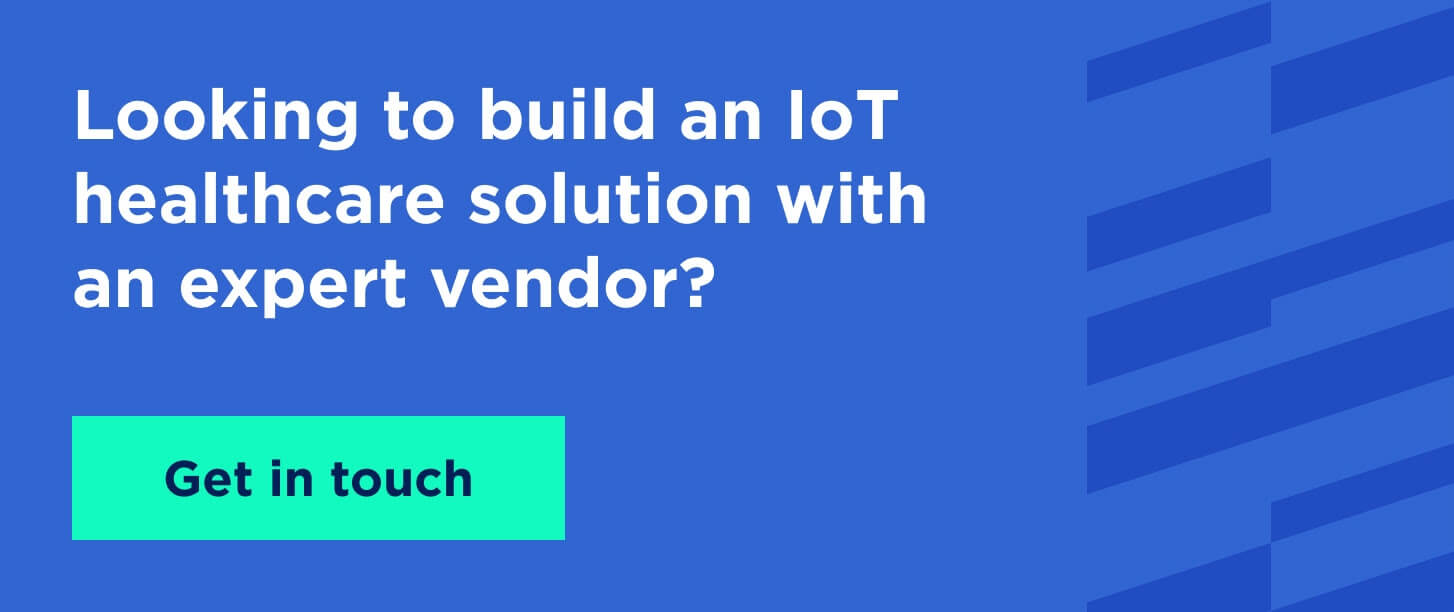The global Internet of Medical Things market shows steady progress and is estimated to hit revenue of US$83.81bn by 2024 and expand to US$134.40bn by 2029. As demand for accessible and personalized care persists, IoT-enabled innovations emerge as transformative tools for automating administrative tasks and early disease prevention. They introduce positive advancements to the healthcare sector by enhancing the experiences of patients and healthcare workers.
Curious about how the benefits of IoT can enhance healthcare delivery, and what are the prominent IoT in healthcare examples? Keep reading to find out!

5 Real-Life Examples of IoT in Healthcare
The use of IoT introduces a new generation of healthcare technologies, aimed to address the significant gaps in the field of medical services. Explore the five IoT-empowered examples of devices built by Lemberg Solutions, designed to meet growing demand for better and more affordable treatment:
Remote patient monitoring

An electronic medical tablet for intensive care specialists built by Lemberg Solutions for a German healthcare company is one of the best IoT examples in healthcare for remote patient monitoring. The shortage of intensive care staff negatively impacts the quality of healthcare, as one physician may be assigned to several patients, making it physically hard to constantly monitor their condition.
Our device relieves the burden on healthcare professionals, enabling remote tracking of core vital signs and sending notifications to physicians if the patient requires a check-up. We also integrated a voice control feature, following accessibility standards to make the device user-friendly.
These IoT devices in healthcare reduce the dependence on frequent in-person consultations, thus cutting down the personal expenditures on medical services. This way, hospitals can improve healthcare systems efficiency — taking patients with severe conditions while discharging those whose condition is stabilized and monitoring their health status using connected devices.
Hand hygiene control

Since hand hygiene is a crucial safety measure, we developed an IoT device based on the computer vision algorithm to control how well people apply UV-reactive sanitizer. Our experts applied a strategic approach to design the device and special algorithm. We created a box made of opaque plastic with an opening in the front to insert hands for scanning. Then, our custom computer vision algorithm analyzes the data to visualize the sanitizer coverage on the hands and indicates areas that need more attention.
This is one of the many notable IoT healthcare use cases which improves handwashing practices as computer vision algorithms show the quality of disinfection invisible to the human eye. Such IoT devices for healthcare provide an innovative and more accurate method to real-time hand hygiene monitoring, which helps to reduce the chances of infection spread.
Cough sound recognition

Lemberg Solutions team worked on a SBC-based IoT gateway device for a German telemedicine company to remotely monitor cough symptoms. A sensor-based device catches the cough sounds and smart AI algorithms, process the recordings, filtering out irrelevant sounds and extracting only useful medical data.
Doctors can access the records in the cloudbase for further evaluation of the cough frequency and intensity. Based on that, they can provide patients with personalized treatment recommendations. Our professionals also implemented solid security measures to ensure that cloud base stores the sensitive patient information following the industry-recognized data protection regulations.
Internet of Things healthcare devices for cough detection greatly assist medical staff to make clinical assessments and assign effective treatment plans. They allow them to intervene in time and change the treatment plan if the cough becomes more severe, while preventing hospitalization.
3D bioprinters

The Swedish bioconvergent startup CELLINK is a well-known manufacturer of 3D bioprinters for the production of organ and tissue substitutes and the creation of customized medical devices. The startup actively contributes to transforming the healthcare by providing individualized solutions for each patient, substantially decreasing the waiting time for donor organs and supporting the advancements in the domain of regenerative medicine.
Lemberg Solutions embedded experts cooperated with CELLINK to optimize the performance issue of their device by enhancing the communication process of Qt apps, middleware, and firmware. Also, we have worked on bioprinter's functionality extension by testing the new features before launching them into production. IoT-empowered bioprinting devices enable a high compatibility with the human body by utilizing patients’ biomaterials, lowering the risk of immune system rejection.
Activity tracking

In recent years, the medical device market has seen more Internet of Things healthcare examples aimed at providing detailed real-time data on human movement, especially for those with limited mobility or undergoing rehabilitation. An activity tracking mechanism built by Lemberg Solutions can efficiently detect human movements and aid to locate a person within a certain area. This solution provides valuable insight into a person's daily physical activity while also alerts caregivers about sudden changes in movement, such as falls.
To implement this healthcare technology, we utilized a combination of a beacon, a smartwatch, and a remote server for data processing. Our experts installed beacons in each room, and as soon as a person enters it, the smartwatch detects the distance to the beacon to determine their location and sends the data to the remote server. All motion changes are visualized on the app's dashboard for caregivers to take immediate action if necessary.

Benefits of IoT in healthcare
If implemented correctly, IoT holds immense potential to resolve the most acute challenges the healthcare industry faces and drive advancements in disease diagnosis and treatment. We collected the top benefits of how IoT devices used in healthcare elevate patient care quality to an entirely new standard:

Health monitoring
The Internet of Things in healthcare enables seamless, real-time control of various vital signs. IoT-empowered devices allow people to track their indicators no matter whether for personal fitness or medical insights to track physical activity, improve their habits and stay aware of key health metrics.
IoT medical devices monitor glucose levels, heart rate fluctuations, and symptoms of depression or mood swings by using sensors to efficiently record data. With smart devices, people can keep an eye on their vital signs to spot early signs of health problems and seek professional medical advice.
Improved patient experience
4.5 billion people lack access to the basic healthcare services. The main reasons for this statistic are the poverty and shortage of proper medical infrastructure in rural regions. The Internet of Things technology, with its remote health monitoring capabilities, helps to solve these issues and provide quality medical care for all individuals, regardless of their situation.
Telemedicine is one of the best IoT healthcare examples, which is practical for people who cannot visit hospitals for different reasons. The only things needed to get a professional medical assessment are the phone and Internet connection. Using video conferencing and remote diagnostic tools, doctors can conduct virtual examinations, diagnose accurately, and develop effective treatment plans.
Telemedicine, as the future of healthcare, allows people to get medical care with physicians from any location in the world, boosting patient experience and making medical care more accessible.
Predictive analytics
Over 3 million deaths could have been avoided with enhanced prevention care and healthcare interventions. Using data collected by IoT devices for medical purposes, healthcare professionals can identify the diseases in its early stages, even before the first symptoms appear.
Machine learning and AI tools help healthcare professionals to forecast the possible health issues like diabetes, tumors or heart diseases, before they develop into serious life threats. Moreover, with predictive analytics healthcare providers can prescribe drugs based on patient data. It takes into account the patient’s sensitivity to certain drugs, reducing the chances of severe side effects.
Error minimization
The World Health Organization states that administrative errors account for up to half of all errors in medical care. Usually, administrative errors, those associated with patient monitoring and medication dispensing, can occur for various reasons, such as lack of personnel, burnout, or bad working conditions.
The incorporation of IoT in the healthcare industry automates manual and routine tasks by collecting all patients’ vital health indicators and tracking medication usage by connected sensors. This way, healthcare providers have more time to concentrate on refining treatment strategies and ensuring positive patient outcomes.

Summing up
IoT devices for healthcare are steadily transforming the industry, optimizing patient care and treatment efficiency. Remote patient monitoring, hand hygiene control, cough sound recognition, 3D bioprinters and fall detection are just a few IoT use cases in healthcare that in the long term will help to improve the state of global population health, prolong vitality and drive innovation in medical research.
Lemberg Solutions boasts over 15 years of experience in healthcare software development. We can seamlessly incorporate IoT into your medical solution, following HIPAA, GDPR, IEC 62304:2006, ISO13485, and other IoT security standards.
